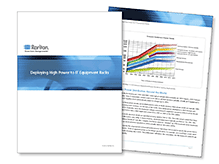部落格
主頁 » 部落格 » Single-Phase or Three-Phase Input Power for Rack PDUs
Single-Phase or Three-Phase Input Power for Rack PDUs
Posted on November 20, 2016 by Gento

Over the past few years, average power consumption per server has rapidly increased with the adoption of high-power computing equipment like blade servers. The typical power required at a rack has increased from 2 kilowatts to 12 kilowatts and continues upward. In addition, ongoing deployment of densely packed storage, virtualization, and cloud computing results in data centers with greater watts/sq. ft. requirements due to more densely packed racks such as a rack filled with 1U servers. To support new, power-hungry IT equipment, data center managers have to deliver more power to the IT equipment rack.
To accommodate the increased power distribution demands at IT equipment racks, data center managers are deploying rack PDUs capable of supplying multiple circuits, higher voltages and higher currents. One way to increase the power at the rack is to increase the voltage coming to the rack and the number of circuits at the rack.
The amount of power available for use is referred to as apparent power. It is calculated as volts x amps and is described as volt-amps or VA. A 120V, 20A circuit has an apparent power of 2400VA or 2.4kVA. A 208V, 20A circuit has an apparent power of 4160VA or 4.2kVA. Thus one 208V circuit provides almost twice as much power as one 120V circuit assuming the current (amperage) remains the same.

With three 208V circuits it is clear that a substantial amount of power can be deployed in one three-phase PDU. To calculate the apparent power of a three-phase power feed the calculation is volts x amps x the square root of 3 which is 1.732. A three-phase 208V, 20A feed is 7205VA or 7.2kVA (208V x 20A x 1.732).
The cable to provide power to a three-phase PDU is thick and heavy but not as thick and heavy as the multiple, individual cables required to provide the same amount of apparent power using either single phase 120V or single phase 208V. Running a single three-phase power cable to each three-phase rack PDU reduces both the number of cables, making installations easier, and the physical bulk of the cables, so less space is filled with cables which can block necessary cooling airflow under raised floors and within IT equipment racks.
In cases where power needs to be provided at 120V for devices such as routers, hubs and switches, as well as at 208V for demanding servers, three-phase Wye PDUs can provide outlets with both 120V (one of the three lines and a neutral) and 208V (two of the three lines). Three-phase power at the IT equipment rack is a convenient way for data center managers to efficiently deploy both greater power capacity and flexibility.

Are you considering deploying high power to your IT equipment racks? Download our white paper, Deploying High Power to IT Equipment Racks, to learn about high power best practices, trends, common configurations, future industry speculation and more.
Other Blog Posts
- 從資料中心失效對企業帶來的骨牌效應──探討感測器的重要性
- Posted on November 5, 2023
- 更高規格的電源要求加速AI市場成長與Raritan PDU的採用
- Posted on October 11, 2023
- 資料中心服務中斷次數減少,但停機的代價仍舊可觀
- Posted on September 20, 2023
- 意見調查:資料中心面臨能源使用與人力短缺困境
- Posted on September 20, 2023
- Raritan安全切換器:相容於Secure NIAP 4.0的桌上型KVM
- Posted on September 20, 2023
訂閱
近期活動
- New Zealand Cloud & Datacenter Convention 2022
- 3 November 2022, 9am – 4pm • Grand Millennium Hotel, Auckland, New Zealand
- Data Centre World Singapore
- 12th – 13th Oct 2022
- Korea Cloud & Datacenter Convention 2022
- 6th Oct 2022
- Philippines Cloud & Datacenter Convention 2022
- 4th Aug 2022
- JANOG50 Meeting Hokkaido
- 3th – 15th July 2022
Raritan最新新聞
- Legrand 使用兩大創新智慧型機架 PDU 重新活化資料中心產業
- Posted on May 1, 2023
- Exclusive interview丨How does Huizhou upgrade its manufacturing industry?
- Posted on December 2, 2021
- Raritan 發表 MasterConsole® 數位雙電腦切換器
- Posted on February 18, 2021
- Legrand Data, Power and Control Division Announced as Finalist in Six Categories at DCS Awards 2020
- Posted on November 9, 2020
- Raritan 新款智慧機櫃控制器 (SRC) 可智慧管理資料中心與關鍵任務設施的環境與安全性資訊
- Posted on November 9, 2020